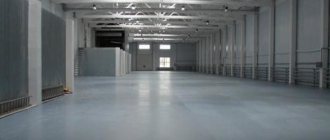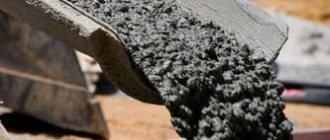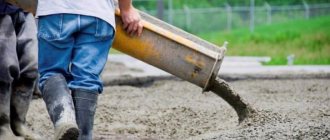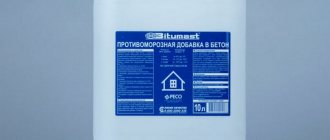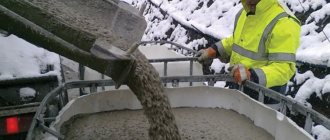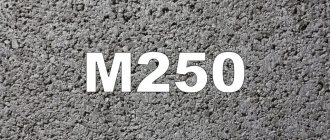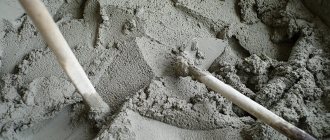Very often during construction it is necessary to pour concrete at sub-zero temperatures or during the work the weather suddenly deteriorates. In such cases, heating methods, insulation of structures, etc. are used. But before applying the above heating methods, it is necessary to carefully study its implementation conditions and features. In such cases, the most economical method is to use a high-quality antifreeze additive that allows you to work in winter.
What we recommend
“ArmMix Nordplast” has proven itself well as an anti-freeze agent for concrete and mortar - it is a ready-to-use complex composition that reduces the amount of mixing water, plasticizes and prevents the formation of efflorescence on the masonry and concrete surface. Allows you to carry out work from +30 to -15 degrees Celsius.
>>> Full description and consumption calculator
Comparative characteristics with other additives
Economically, this composition is much more profitable than other “classic” anti-frost materials:
Sodium formate
Sodium formate HCO2Na is the basis for the production of liquid antifreeze additive in canisters, used by builders for winter concreting! Allows operation down to -15°C. More details>>>
Sodium nitrite
Technical sodium nitrite NaNO2 (NN) in powder form is used as an anti-freeze agent in the production of building products and structures down to -15°C, and also as an inhibitor of atmospheric corrosion. More details>>>
Potash
Potash (technical potassium carbonate, formula K2CO3) is a strong accelerator for the setting of mortar mixtures, allowing concrete to be cast down to -20°C. More details>>>
Other additives
You can find out about the comparison with other additives in the following article “Cheap antifreeze additives - is it really profitable?”
Information on the economic feasibility of Nordplast
The price of concentrated antifreeze for concrete and mortar ArmMix Nordplast is 90 rubles / liter.
Consumption - 1-2 liters per 100 kg of cement.
Can be used in cold temperatures down to -15°C
You can (Word format) or our manager and find out detailed information about the effectiveness of using antifreeze additives, as well as their exact cost.
Antifreeze additives for concrete mortar
Concrete additives are used very often today, and anti-frost additives occupy a special place, as they allow work to be carried out almost all year round. The concrete mixture contains about 10% water and when the temperature drops, it begins to freeze. If, when the temperature drops, all processes in concrete simply slow down, then at minus temperatures, hardening stops altogether.
And then, when the process may continue during thawing, it already occurs with a violation of the technology, strength and resistance to mechanical loads, and other characteristics may decrease. To preserve the ability of the solution to gain strength, it is necessary to leave the water liquid even at minus temperatures, which is achieved using additives.
Plasticizer additives improve the dispersion of all solid components of the cement mortar. The friability of sand, gravel, and binder increases, the mixture becomes a suspension, and resistance to freezing increases to -15 degrees, and the hardening process usually accelerates.
The disadvantage of introducing such additives into concrete is the presence of chlorides in their composition, which can cause reinforcement to corrode. But some manufacturers offer additives without chlorides; they are better suited for pouring concrete with a reinforcing frame.
Difficulties of winter concreting
Any concrete solution is a mixture of a certain brand of cement, fine filler (quartz quarry or river sand), coarse filler (granite or limestone crushed stone, gravel) and water. All components are taken in a certain proportion, mixed thoroughly, and placed in a mold.
Next, the cement begins to interact with water (a hydration reaction occurs), begins to set and harden gradually (the process is completely completed after 28 days). Normally, this process takes place only at positive temperatures, but minus temperatures negatively affect the monolith.
What changes can occur in concrete under the influence of minus:
- The hydration process takes noticeably longer – when the temperature drops below +5.
- At temperatures below 0, an ice crystal lattice forms in a liquid solution. During the freezing process, ice crystals increase in volume and cause the appearance of local stress zones in the still weak solution, as a result of which the structure is destroyed and breaks in the bonds of cement particles appear.
- When the concrete has already frozen, an ice crust appears around the metal parts, pushing the cement mass away from the steel reinforcement and thus compromising the integrity of the reinforced concrete products.
- When free water turns into ice, the volume of water decreases and then, when it thaws, it becomes insufficient for hydration.
All these phenomena are more dangerous the earlier the concrete freezes. If it has not reached at least 50% of its design strength, freezing can have a detrimental effect on quality and strength, significantly reducing performance.
Ways to combat solution freezing
The main task of winter concreting is to protect concrete solutions from freezing for as long as possible by keeping water in liquid form rather than ice. Several different methods are used for this.
Basic methods of combating freezing of concrete solutions:
- Thermos effect
– the formwork for pouring is created from heat-insulating materials, and the components themselves for preparing the solution are heated (liquid, sand and crushed stone, but not cement), then the mixture is poured and covered with heat-insulating materials. This way it is possible to prevent the concrete from freezing until the moment when the frost is no longer afraid of it.
- Heating the solution in the formwork using different methods
– steam, by passing current through it, using special devices. But this is a rather labor-intensive process and requires the use of special equipment.
- Creation above the place where the mixture is poured
closed hut or canopy, heated by diesel or electric heat guns.
- Antifreeze
– introduction of antifreeze additives into the solution, which accelerate hydration and protect water from freezing.
The main advantages of antifreeze
Antifreeze additives can be dry or liquid. Liquids include ammonia water obtained by dissolving ammonia gas in water. The additive makes concrete frost-resistant, prevents reinforcement from corroding, and accelerates the hardening process of the monolith. Also on the market are a variety of solutions and universal mixtures made on the basis of dry substances. You can make an anti-frost additive to concrete with your own hands, but to do this you first need to understand the substances.
Types of dry additives in concrete mixture against frost:
- Potash (aka potassium carbonate)
– activates the hardening of concrete, lowers the freezing temperature. It is usually added to the composition with borax (sodium tetraborate), because in its pure form it reduces the strength indicator. The potash mixture sets quickly and is difficult to work with, so a superplasticizer is usually added.
- Sodium tetraborate
– used alone or with potash, preserves the structure of concrete after thawing, reduces the water permeability of the monolith, increases strength and prevents cracks from appearing.
- Sodium/calcium formate
– significantly accelerates the hardening of concrete, working in a similar way to a plasticizer. Usually used with naphthalene lignosulfonate. The composition is introduced in a concentration of a maximum of 6% of the total mass of the solution.
- Sodium nitrite
– lowers the freezing point of water in concrete, allowing the use of a non-freezing solution at temperatures from zero to -25 degrees.
What additives are added to complex formulations and how they are labeled:
- NC – calcium nitrite;
- M – urea;
- CC – calcium chloride (prohibited for use in reinforced concrete);
- MNC – urea, calcium nitrate;
- P – potassium carbonate (potash).
High-quality industrial additives often perform several functions simultaneously: regulating the rate of strength gain, lowering the freezing temperature of the solution, accelerating reactions, changing the properties of the mixture.
What additional properties do the additives provide:
- Increasing the mobility of the mixture, improving its distribution, reducing the volume of cement in the solution, increasing moisture resistance. Plasticizers based on organic polyacrylates, melamine resin sulfates or naphthalene have this effect.
- Significant increase in strength - strengthening additives based on iron and aluminum sulfates, calcium chloride and calcium nitrite.
- Protecting fittings from corrosion, extending the service life of products - corrosion-resistant additives.
- Mobility regulators significantly extend the time of working with the solution and prevent it from setting quickly.
- Complex action additives work in several directions at once.
The most effective is the use of ready-made liquid additives of complex action, which perform all the functions assigned to them and provide a lot of advantages. In Moscow and the regions it is not difficult to find mixtures; there are quite a lot of them on the market.
The main advantages of introducing antifreeze additives into the solution:
- The freezing point of water in the mixture decreases.
- Plasticizers reduce density and increase mobility without the need to add excess liquid, which allows for better and more comfortable pouring of the solution.
- Corrosion inhibitors are often added to anti-freeze products to protect steel reinforcing elements from oxidation and destruction.
- The strength gain of concrete accelerates to a point after which various impacts are no longer dangerous.
- Increasing water resistance, as well as the design strength of the finished monolith.
- Allows you to save money compared to the use of other methods that provide the possibility of pouring concrete at a disadvantage.
Features of working with antifreeze additives
A do-it-yourself anti-freeze agent for concrete, provided the correct choice of substances and their volumes is used, can provide the same properties as an industrial mixture. But it is much easier to purchase a ready-made solution with the correct proportions and desired properties. It’s easy to work with additives, the main thing is to follow the technology.
How to work with anti-freeze for concrete:
- Pour the required volume of water into the concrete mixer, pour anti-freeze liquid into it in the volume specified in the instructions.
- Allow the mixture to stir for 5-10 minutes.
- Without stopping stirring, load half the volume of sand into the container, then the entire volume of cement, then the rest of the sand.
- Load the entire volume of coarse filler into the concrete mixer and allow it to mix completely until the mixture is homogeneous.
- Develop the solution within the time specified in the instructions (the period may vary due to the properties of the additive).
The problem of organizing brickwork in cold weather
When conducting construction in winter, it becomes most problematic to provide structures with the necessary strength. When the temperature drops below zero, the liquid in the solution crystallizes. Thus, the process of cement hydration stops.
As the air temperature rises, the ice formed inside the masonry and on the surface of the building material begins to melt, which necessarily causes a decrease in the adhesion of the mortar. Another negative effect is the formation of small cavities in the concrete structure, which can subsequently lead to fairly rapid destruction of walls and ceilings.
Dosage and consumption
The amount of antifreeze additive required depends on the following factors:
- strength of the cement used;
- ambient temperature indicator;
- chemical composition of the protective mixture.
How much additive is required to obtain a certain strength of concrete mortar is presented in the table:
| Average air temperature | Amount of additive,% of total mass | Expected strength of the solution, % of the grade when hardening in the cold, day | |
| 7 | 28 | ||
| 0 to -5 | 2 | 25 | 60 |
| -6 to -10 | 3 | 15 | 45 |
| -11 to -15 | 4 | 5 | 35 |
Plasticizers
The antifreeze additive in the solution can be replaced with special plasticizers, which increase the elasticity of the building mixture and reduce the need for the use of liquid.
Thanks to the use of the latter for several days, virtually no changes occur in the laid composition. Thus, the solution has time to set even in severe frosts. In addition to masonry, this specific anti-frost additive can be used for glue, preparing mixtures for arranging self-leveling floors, and when performing concrete work. Plasticizing agents are mixed with a minimum amount of water. Their content in the solution is about 5% of the weight of cement. Compliance with this proportion is sufficient to perform reliable masonry in conditions of low temperatures.
Types of additives
Experts distinguish 2 groups:
- retarders or weak accelerators of hardening;
- impurities that accelerate the hardening of the concrete mixture.
Classification of chemical-based additives
| Name | Characteristic |
| Antifreeze | Reduces the crystallization temperature of the mixture |
| Does not affect the rate of structure formation | |
| Increases or slightly decreases the speed of setting of the solution | |
| Sulfates | Provides greater speed of creating mixture density |
| Promote heat release | |
| Accelerator additives | Lowers the freezing point of liquid |
Can PMDs worsen the properties of concrete?
PMDs allow construction work to be carried out in winter, but they must be used within reasonable limits. They are toxic and require builders to be careful, otherwise they can cause skin burns and other damage.
Additives with chlorides cannot be used if the solution is poured onto a reinforcing frame, because the metal may corrode.
Potash, or potassium carbonate, as well as calcium nitrate in additives can form hot spots in the monolith, which weakens the structure.
When choosing an additive with antifreeze properties, you need to take into account many factors - air temperature, quality and type of PMD, composition and brand of cement, purpose of the construction site. A correctly selected “anti-freeze agent” added in the required concentration will improve the concrete mixture.
Features of solution preparation
Despite the difficult working conditions, bricklaying in winter can be no less high quality than in the warm season. However, in order to obtain the expected result, it is necessary to prepare a special solution, which must contain antifreeze additives.
When starting to prepare the building mixture, you need to take care of your personal safety. It should be borne in mind that almost all antifreeze additives differ in their composition based on quite aggressive chemicals that can cause harm to health. Therefore, when preparing concrete, you need to work in thick gloves, safety glasses, rubber boots and, if possible, special clothing.
For the above reason, building mixtures containing toxic substances are not recommended for use in the construction of foundations and load-bearing walls of buildings. Also, anti-frost additives in masonry mortar are prohibited from being used for work inside residential premises.
What do you need to know about performing masonry work in winter?
In order not to be disappointed in the results of construction activities that are carried out at negative air temperatures, it is enough to pay attention to the following recommendations:
- It is prohibited to use building materials covered with snow, frost or ice for masonry.
- All components of the future solution, including antifreeze additives and plasticizers, should be stored in dry, ventilated areas at room temperature.
- Regardless of the composition of the mortar and temperature conditions, it is recommended to carry out masonry work as quickly as possible in winter. The lack of delay allows the substances to set faster.
- When going on a break, the rows of masonry must be insulated with plastic film or other suitable material suitable for the role of an effective temporary insulator.
- As a basis for preparing the solution, you should use cement of a grade not lower than M-50. Mixing the components, even if “antifreeze” is used, should be carried out in a warm room.
- If it is necessary to work at low temperatures, it is better to give preference to purchasing ready-made solutions to which antifreeze substances are added in optimal proportions at the production stage.

